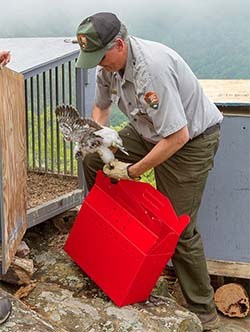Name: Rolf Gubler, 52
Position: National park ranger, Shenandoah National Park
What he does
When you startle a black bear, prompting it to charge toward you and stop maybe 10 or 15 feet away, it's called a bluff charge.
"That's pretty scary the first time it happens," says Rolf Gubler, a biologist and forest pest manager at Shenandoah National Park. "People always remember their first bluff charge."
Part of Gubler's work in the division of Natural and Cultural Resources is managing relations between the park's visitors and the 50-plus species of mammals that inhabit Shenandoah, including about 400 to 600 black bears. His team of "bear techs" educates visitors on food storage compliance and trash management, and they handle illegal wildlife feeding, bear jams (when traffic backs up due to a sighting) and, as a last resort, animal capture, trapping and relocation.
"We say, 'Hey, folks, you really need to properly store your food -- you can't go hike and leave it at the picnic table for two hours and expect it to still be there,'" Gubler says. "All it takes is for a bear to get a food reward, and then it can become food conditioned and become an animal that causes property damage … and needs to be relocated to a new area."
One of Gubler's focuses this spring was reintroducing peregrine falcons to the park. The birds -- known for their fast flying and blue-gray wings -- declined sharply in the eastern U.S. in the mid-20th century as a result of the pesticide DDT, and they're still considered a threatened species in Virginia. Shenandoah works with groups like the College of William and Mary's Center for Conservation Biology and the Virginia Department of Game and Inland Fisheries to take at-risk falcon chicks from eastern Virginia, get them ready for flight through a process called hacking and then release them from the park's Franklin Cliffs.
"The falcons are protected in a hack box, like a big doghouse, and after two weeks or so they learn how to fly and hunt on their own," Gubler says. "Visitors can come up and watch [the release], and it's a pretty unique experience."
Aside from the wildlife, there are nearly 200,000 acres of park that need to be managed, too. Gubler is particularly concerned with suppressing the emerald ash borer -- a green jewel beetle -- and hemlock woolly adelgid, a sap-sucking insect that ravages hemlocks. "Tens of millions of trees have died because of the emerald ash borer," Gubler says. "We try to find money to support our work against it. Some of it's suppression work; some of it's pesticide treatments; but eventually, some of it's gonna have to be money for tree removal work."
How he got the job
Gubler headed to Pennsylvania State University as a wildlife science major, but found that he equally enjoyed his required forestry courses, so he added forest science as a double major -- which meant staying five years instead of four. After graduating in May 1988, he joined the Shenandoah staff as a seasonal biological technician. Six months later, a position opened in the air quality monitoring program, and Gubler decided to give it a try.
"It was a little outside my interest area, but it's very competitive to get into the park service," he says. "I ended up working two or three different roles and got into the natural resources area and became a biologist." He marked 30 years at the park in May.
Who would want the job
If you're going to spend your days in a national park, it goes without saying you need to like the outdoors. "You have to have a passion for the protection of wildlife and natural resources," Gubler says. An interest in working with rare plants or suppressing exotic insects is helpful, too. "We're really out there to preserve what's here, to preserve the native species."
How you can get the job
Find a college with a good program in wildlife science or forest ecology, and get a bachelor's followed by a master's degree, Gubler suggests. From there, your exact route depends on what you want to be doing in a national park. At Shenandoah, there are five divisions of park rangers: Ranger Activities (like search and rescue); Interpretation and Education; Maintenance; Administration; and Gubler's division, Natural and Cultural Resources.
As Gubler points out, few other offices can boast such striking, varied co-workers. "I fell in love with [Shenandoah]," he says. "Growing up in eastern PA, you didn't see things like black bear and bobcat and wild turkeys. Here, you're down in the valley canoeing in the river and it's routine to see osprey and bald eagles."


